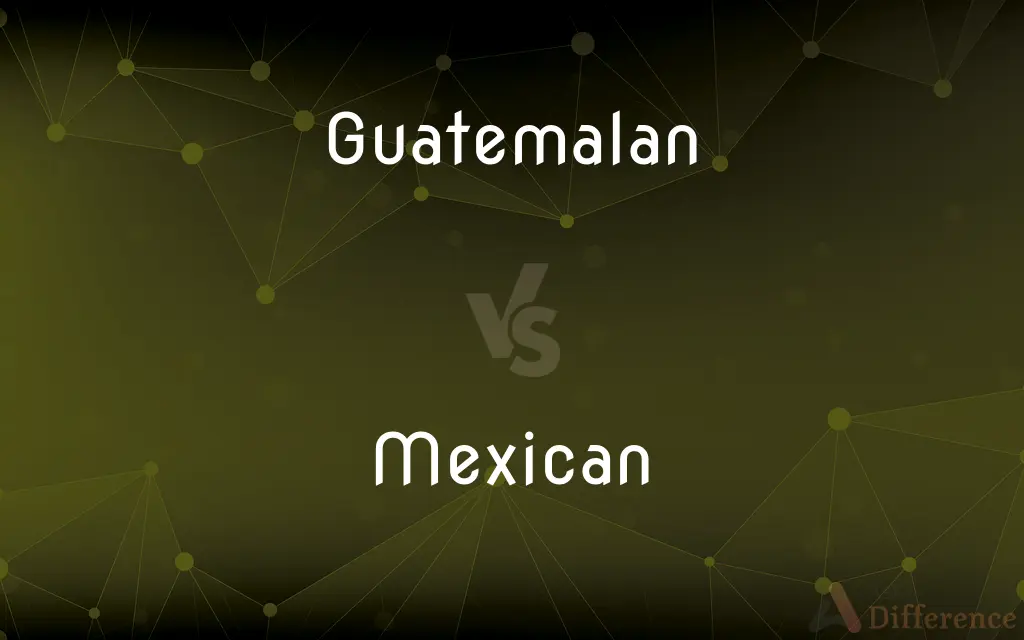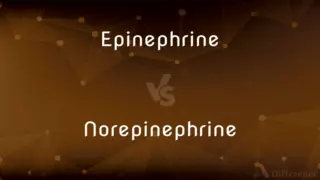Guatemalan vs. Mexican — What's the Difference?
By Tayyaba Rehman & Fiza Rafique — Updated on April 4, 2024
Guatemalan refers to anything related to Guatemala, a country in Central America. Mexican pertains to Mexico, a country in North America.

Difference Between Guatemalan and Mexican
Table of Contents
ADVERTISEMENT
Key Differences
Guatemala and Mexico share a border, but they have distinct cultures, histories, and geographies. Guatemala, located in Central America, is known for its rich Mayan heritage and diverse landscapes that include rainforests, volcanoes, and ancient ruins. Whereas, Mexico, extending from the southern part of North America to its narrow isthmus leading into Central America, boasts a powerful mix of Indigenous, Spanish colonial, and modern influences, evident in its food, art, and architecture.
Guatemalan cuisine is known for its use of traditional Mayan staples like corn, beans, and chilies, featuring dishes such as pepian and kak'ik. On the other hand, Mexican cuisine has gained international fame, characterized by its use of corn, beans, tomato, chilies, and avocado, with famous dishes like tacos, enchiladas, and mole. While both cuisines value corn and beans, Mexican food is generally more diverse due to regional variations.
In terms of language, Spanish is the official language of both countries, but Guatemala recognizes 21 Mayan languages as national languages, reflecting its indigenous roots. Conversely, Mexico is home to a large number of indigenous languages as well, with Nahuatl and Maya among the most spoken, highlighting the rich linguistic diversity in each country.
Culturally, Guatemala is known for its colorful textiles and Mayan ruins, such as Tikal, and a strong indigenous culture that influences its festivals, music, and art. Mexico’s culture is a rich tapestry that includes iconic elements like mariachi music, Day of the Dead celebrations, and Aztec and Maya ruins like Teotihuacan and Chichen Itza. Both countries have vibrant cultures, but Mexico's cultural exports are more recognized globally.
Politically and economically, both countries face challenges, but their paths have been shaped by their unique histories and geographical positions. Guatemala's political history is marked by civil war and political instability, while Mexico has faced its own share of political upheaval, drug violence, and economic disparity.
ADVERTISEMENT
Comparison Chart
Location
Central America
North America
Cuisine
Features traditional Mayan staples, less internationally known
Internationally recognized, with regional variations
Language
Spanish and 21 Mayan languages as national languages
Spanish, Nahuatl, Maya, and other indigenous languages
Culture
Known for colorful textiles, Mayan ruins
Known for mariachi, Day of the Dead, Aztec and Maya ruins
Challenges
Political instability, economic challenges
Drug violence, political upheaval, economic disparity
Compare with Definitions
Guatemalan
Pertaining to Guatemala, its people, culture, or language.
Guatemalan textiles are renowned for their vibrant colors and intricate designs.
Mexican
Related to Mexico, its people, culture, or language.
Mexican cuisine is celebrated worldwide for its flavors and diversity.
Guatemalan
Known for dishes like pepian and kak'ik.
For dinner, we enjoyed a traditional Guatemalan pepian, a rich, spicy stew.
Mexican
Day of the Dead celebrations, mariachi music.
The Day of the Dead is a vibrant Mexican celebration honoring ancestors.
Guatemalan
Mayan ruins, such as Tikal.
Visiting the ancient Mayan ruins of Tikal is a highlight of any trip to Guatemala.
Mexican
Famous for tacos, enchiladas, and mole.
Tonight, we're making tacos, a staple of Mexican cuisine.
Guatemalan
Spanish and 21 Mayan languages.
Many Guatemalans are bilingual, speaking Spanish and a Mayan language.
Mexican
Spanish, Nahuatl, and Maya are widely spoken.
In Mexico, you'll find a rich linguistic diversity, including indigenous languages like Nahuatl.
Guatemalan
Faces issues like political instability.
Guatemala has been working to overcome its history of political instability.
Mexican
Drug violence and economic disparity.
Mexico continues to confront challenges like drug violence and economic disparity.
Guatemalan
Of or pertaining to Guatemala; as, Guatemalan coffee.
Mexican
Relating to Mexico or its people
Authentic Mexican cuisine
Guatemalan
Of or pertaining to the inhabitants of Guatemala; as, Guatemalan rebels.
Mexican
A native or inhabitant of Mexico, or a person of Mexican descent
Urban scenes depicting the daily life of Mexicans
Guatemalan
A native or inhabitant of Guatemala.
Mexican
A native or inhabitant of Mexico.
Guatemalan
A native or inhabitant of Guatemala
Mexican
A person of Mexican ancestry.
Guatemalan
Of or relating to or characteristic of Guatemala or its residents;
Guatemalan coffee
Mexican
Of or relating to Mexico or its people, language, or culture.
Mexican
Of or pertaining to Mexico or its people.
Mexican
A native of inhabitant of Mexico
Mexican
Of or relating to Mexico or its inhabitants;
Mexican food is hot
Common Curiosities
What languages are spoken in Guatemala and Mexico?
Both countries primarily speak Spanish, but Guatemala officially recognizes 21 Mayan languages, while Mexico has a significant number of indigenous languages, with Nahuatl and Maya among the most prominent.
Are Guatemalan textiles different from Mexican textiles?
Yes, Guatemalan textiles are particularly known for their vibrant colors and intricate patterns, often reflecting Mayan symbols and stories, while Mexican textiles also have a rich tradition but with distinct regional styles and influences.
How do Guatemalan and Mexican cuisines differ?
Guatemalan cuisine is known for its traditional Mayan influences, while Mexican cuisine is famous for its regional diversity and international presence.
Can you find Mayan ruins in both Guatemala and Mexico?
Yes, both countries are home to significant Mayan archaeological sites, with Tikal in Guatemala and Chichen Itza in Mexico being among the most famous.
What are some cultural exports of Mexico that are recognized worldwide?
Mexican cultural exports include cuisine (tacos, enchiladas), music (mariachi), and traditions (Day of the Dead).
How does the geographical location of Guatemala and Mexico influence their cultures?
Guatemala's location in Central America contributes to its rich Mayan heritage and biodiversity, while Mexico's position, bridging North and Central America, has resulted in a mix of indigenous and Spanish colonial influences.
What is a significant difference in the celebration of traditional festivals in Guatemala versus Mexico?
Traditional festivals in Guatemala often have a strong Mayan influence, while Mexican festivals, like the Day of the Dead, blend indigenous traditions with Catholic elements.
Do Guatemala and Mexico share any historical or cultural similarities?
Yes, they share historical roots in pre-Columbian civilizations like the Maya, and both have rich indigenous cultures and languages that influence their modern national identities.
What are the main challenges facing Guatemala and Mexico today?
Guatemala faces political instability and economic challenges, while Mexico deals with drug violence, political upheaval, and economic disparity.
How has the political history of Guatemala affected its development compared to Mexico?
Guatemala's recent history of civil war and political instability has impacted its development differently than Mexico, which has faced challenges like drug cartels and economic reforms.
Share Your Discovery

Previous Comparison
Cuff vs. Hem
Next Comparison
Epinephrine vs. NorepinephrineAuthor Spotlight
Written by
Tayyaba RehmanTayyaba Rehman is a distinguished writer, currently serving as a primary contributor to askdifference.com. As a researcher in semantics and etymology, Tayyaba's passion for the complexity of languages and their distinctions has found a perfect home on the platform. Tayyaba delves into the intricacies of language, distinguishing between commonly confused words and phrases, thereby providing clarity for readers worldwide.
Co-written by
Fiza RafiqueFiza Rafique is a skilled content writer at AskDifference.com, where she meticulously refines and enhances written pieces. Drawing from her vast editorial expertise, Fiza ensures clarity, accuracy, and precision in every article. Passionate about language, she continually seeks to elevate the quality of content for readers worldwide.














































